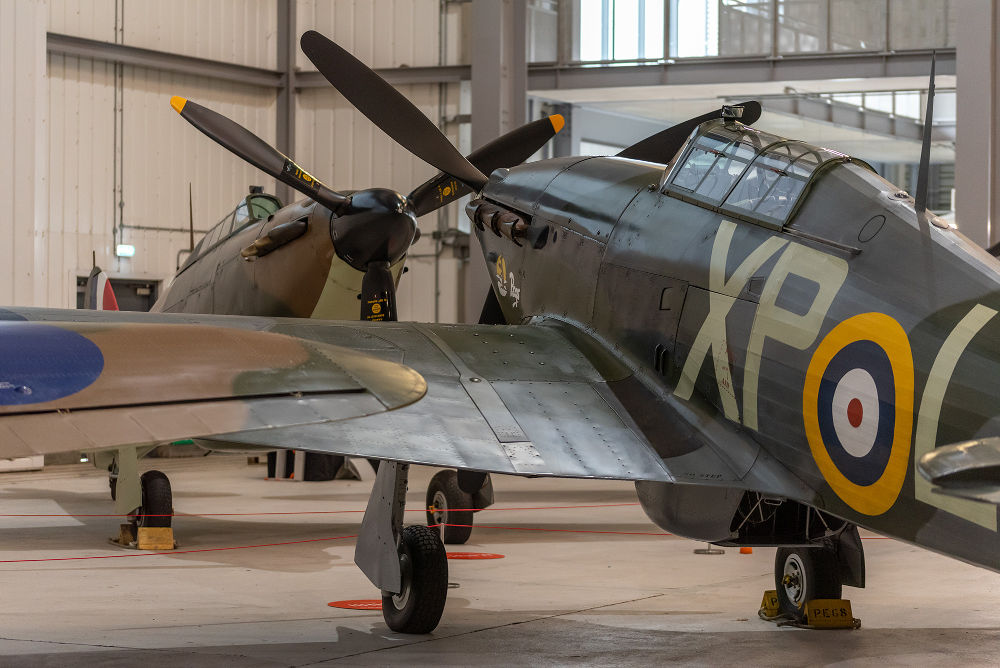Hurricane; Unsung Hero Exhibition – IWM Duxford

On 22 December 2022 Airscene had the chance to preview the new exhibition at the Cambridgeshire branch of the Imperial War Museum. Following on from the success of last year’s popular display of 12 Supermarine Spitfires, this year, the famous Duxford Aerodrome is playing host to a unique collection of Hawker Hurricanes, the unsung hero of the Battle of Britain. The exhibition brings together seven unique and airworthy examples of the Hurricane alongside examples of the Hawker Fury, Nimrod and Hart biplanes – all of which provided the blueprint for the monoplane Hurricane.
During the Battle of Britain, Hurricanes outnumbered Spitfires consistently by two to one. Designed by Sydney Camm, the chief designer at Hawker Aircraft Ltd, the Hurricane would prove to be the workhorse of Fighter Command. With the dawn of the 1930s, the Air Ministry decided to issue a specification for a new high-speed monoplane fighter. These new fighters would require the capability to fly at 250mph while armed with four machine guns. Camm initially presented two designs to the Air Ministry, but both were rejected due to their cautious approach. Undeterred, and without any government backing, he decided to pursue his designs further. The result was the ‘Fury’ monoplane, a development of Camm’s earlier Fury biplane.
The Fury monoplane was ready for flight when the Air Ministry released a revised specification for the new fighters. They would now need to carry eight machine guns instead of four. Rather than allow for a complete overhaul, Camm simply fitted a new pair of wings capable of carrying the extra weight. The Hurricane was born. Despite the hundreds of hours invested in its design, the Hurricane retained many features of its biplane forefathers. It had a wooden frame constructed around a wire-based framework of metal tubes. Over this was stretched fabric, painted thickly with lacquer to stiffen, and protect it.
This marriage of old and new was ingenious. The Hurricane was economic, easy to produce and easy to maintain. Its fabric and wooden frame was less susceptible to enemy cannon fire than all-metal constructions. Shells would simply pass through instead of exploding on impact. Moreover, the Hurricane was easy to repair. RAF mechanics were already well trained in how to service aircraft of its more old-fashioned construction. By contrast, the stressed-metal construction of the Spitfire required skilled training.
The Hurricane was also extremely effective in battle. Its eight guns were fixed as two groups of four as close as possible to the fuselage. This made it perfectly suited to tackling the waves of German bombers it would soon be faced with. The first protype, K5083, flew at Brooklands on 6 November 1935. It was piloted by George Bulman, Hawker’s chief test pilot. Bulman was impressed by how easy the aircraft was to fly. Seven months later, the RAF placed an initial order for 600 Hurricanes. The most numerous RAF fighter during the Battle of Britain, the Hurricane equipped 33 squadrons by September 1940.
During the battle, Hurricanes accounted for 656 German aircraft shot down – more than the Spitfire’s total of 529. Between 30 July and 16 September 1940, 404 Hurricanes were destroyed.
The exhibition features four Mk I Hurricanes (P3717, V497, P2902, R4118), a Mk IIa Hurricane (5711, marked as R4175) and a Mk IIb Hurricane (1374, painted as BE505). The later of which has recently been fitted out as a two-seater and can be booked for passenger flights. The Shuttleworth Collections Sea Hurricane (Z7015) will join the collection in the new year once maintenance is complete. Alongside the Hurricanes you can also see Hawker Fury Mk I (K5674) and the unrestored airframe of a Hawker Hind (L7181). You can also see the Imperial War Museums own Mk Ia Spitfire offering a comparison between the two iconic fighters. Currently, a Hawker Nimrod is filling the space that will eventually be occupied by the Sea Hurricane.
To learn more, visit Hurricane: Unsung Hero, opening 27 December 2022 at IWM Duxford. Also, look out for several celebratory events around the exhibition, including a day with Airfix on 15 January, an evening photoshoot on 4th February and a full day of Hurricane history for the Hurricane Conference on 18 February. Check out the Imperial War museums website for further details;
https://www.iwm.org.uk/events/Hurricane-unsung-hero
Tags: 2022, December, Duxford Imperial War Museum, News
